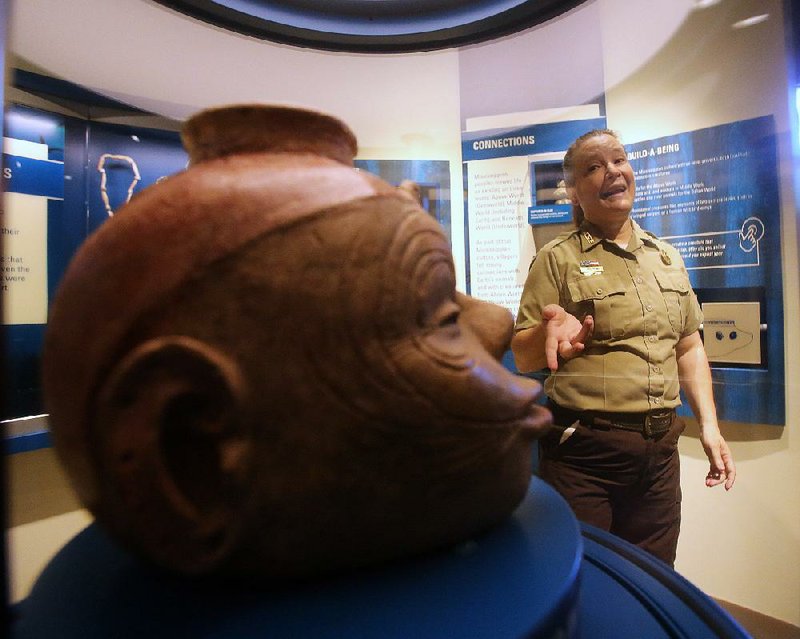WILSON -- Sherry Hawkins, the park interpreter for Hampson Archeological Museum State Park, reached into an overstuffed cardboard box and plucked out a crimson T-shirt.
Staring from the front of the garment was the head of a man with his eyes half-closed, his elongated jaw jutting out, his ears punctured with a ring of circles and his face incised with a maze of intricate lines and curves.
"We think they're tattoos," Hawkins said of the facial indentations.
The image on the shirt depicts an actual artifact -- a human head effigy vessel, or headpot, from between the years 1400 and 1650 from an aboriginal village that once existed about 5 miles east of present-day Wilson in Mississippi County.
The front door rattled as Hawkins told the story of the headpot -- possibly a death vessel used during burial ceremonies -- encased in glass in the middle of the museum's new home on Wilson's town square.
Park Superintendent Tess Pruett hurried to the locked door and stepped outside to talk to the small group.
The sparkling new museum is not yet open for business, but Pruett said she has turned away dozens of visitors on a near-daily basis for several months now. The project broke ground in the spring of 2015 and slowly turned into an 8,460-square-foot facility. It is the first new construction in nearly 60 years on the town's square.
The state park's old facility -- a cramped 1961 red-brick building that borders a pond a few streets down -- was closed about a year ago so the museum's collection could be moved to its new home and the exhibits created.
The new museum is expected to open after a scheduled Sept. 15 inspection and, hopefully, acceptance of the completed exhibits, said Randy Roberson, state parks manager of planning and development.
"The building is essentially complete although the contractor is taking care of some final touches," Roberson said. "The exhibits are near completion."
The facility sports a Tudor-style facade with a wooden-shingled roof to match the rest of Wilson's town square. It stretches along U.S. 61 in a long, winding display area that houses the museum's thousands of artifacts. A driveway curves along the side of the building to accommodate school buses, with a grassy area on the opposite side for picnics.
The building and property -- valued at about $3.6 million, including the exhibits -- belong to the city of Wilson. The project was funded by the city and The Lawrence Group -- a real estate, banking and holdings company headed by Gaylon Lawrence Jr. The company purchased almost all of the Wilson commercial property and 40,000 acres of farmland in 2010 for about $150 million.
The state Department of Parks and Tourism will lease the new museum building and grounds with the option to purchase in the future, Roberson said.
The museum's previous home will eventually be transferred to the city of Wilson.
A full-sized cane hut stands in the middle of the display and interpretative panels, also imprinted in braille, telling the story of the people who inhabited the Delta area nearly 700 years ago.
The impressive collection is the work of Dr. James K. Hampson, who practiced medicine in Memphis, Fort Smith and at Nodena, his plantation outside of Wilson.
It was at Nodena that Hampson began in the early 1920s to excavate the remains of the American Indian group that lived in the 15-acre village in a horseshoe bend of the Mississippi River hundreds of years ago.
The archaeological site yielded thousands of pottery items, tools and farming equipment, hunting weapons and religious objects. A prehistoric mastodon skeleton resembling a modern elephant was also discovered about 2 miles south of the site and is included in the Hampson Archeological Museum collection.
The headpots are rare and are found mostly in northeast Arkansas and the Missouri boot heel, according to Virtual Hampson Museum, an online project completed in 2010 by the Center for Advanced Spatial Technologies at the J. William Fulbright College of Arts and Sciences at the University of Arkansas, Fayetteville.
Only 137 headpots have been identified in the nation, 90 of which were found in Arkansas.
The museum's collection also includes artifacts excavated by Hampson at other regional sites and finds made by the University of Alabama and the University of Arkansas.
Pruett pointed to a stone tool that resembles a modern-day garden hoe.
"This is one of the largest tools we have," she said.
"We're pretty sure they used it because it does have a shine on it," Hawkins added.
The exhibits are accompanied by interactive displays that allow visitors to feel the weight and texture of the artifacts using replicas or view the items from different angles.
Hawkins turned a small gear wheel protruding from the wall and watched as the encased artifact slowly turned.
"We had to damper them because we knew what kids would do," she said, laughing.
Another wall display depicted a dark-red pottery vase. White, magnetized abstract shapes were strewn along the borders. A sign invited visitors to create their own version of the "Nodena Red and White" collection -- ceramics produced by mixing clay with crushed mussel shell and painted in red and white swirls or other shapes.
As Hawkins walked among the exhibits, she pointed to strips of blue masking tape on various displays.
"This means something needs to be fixed," she said. "We are not opening until it's absolutely ready."
SundayMonday on 09/02/2018


